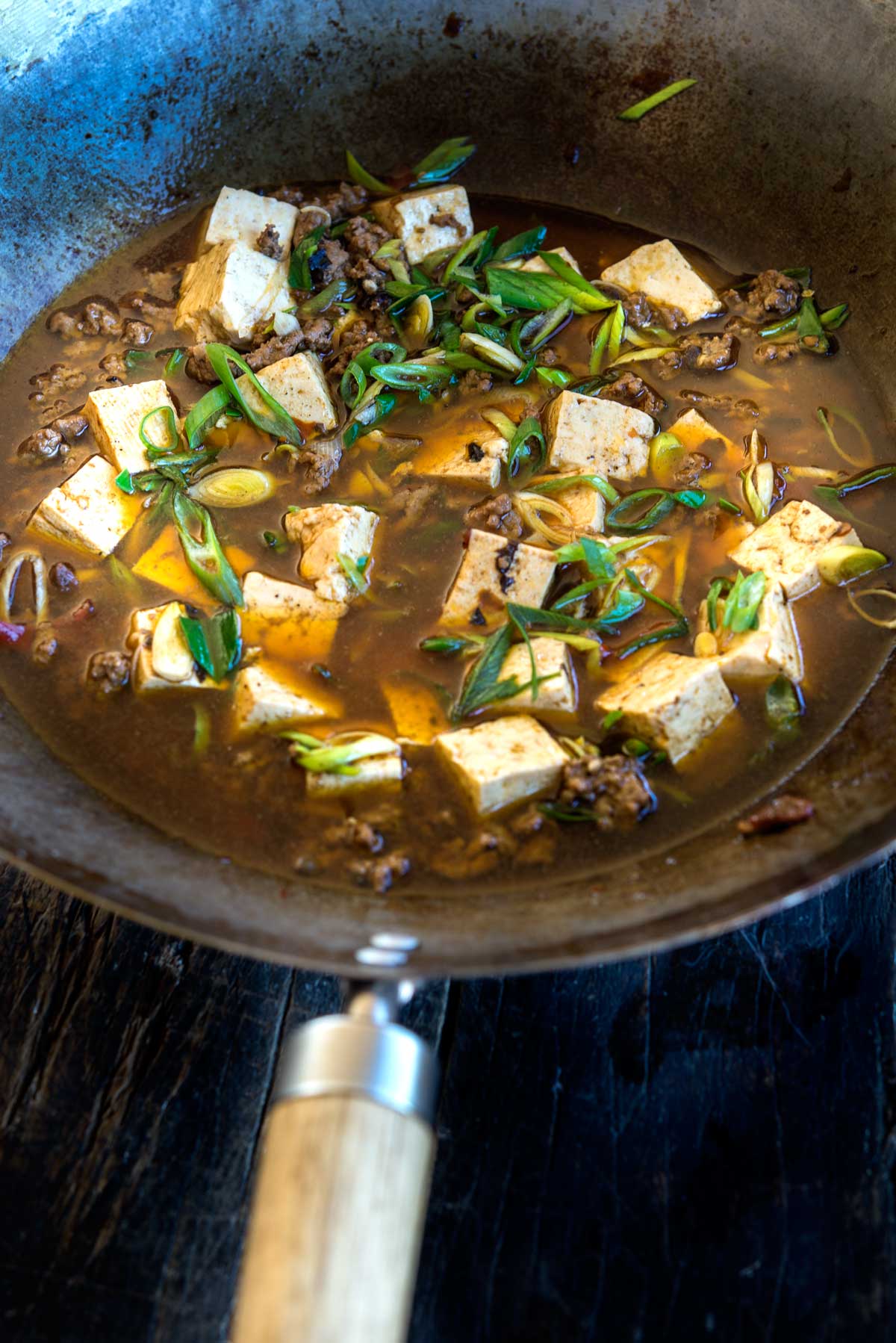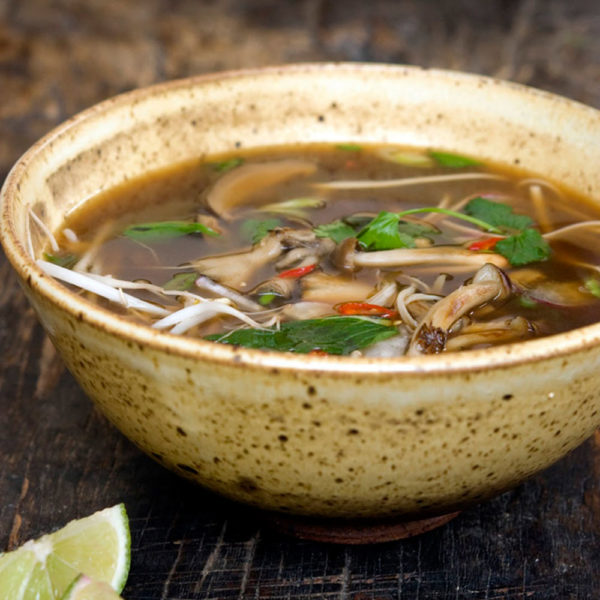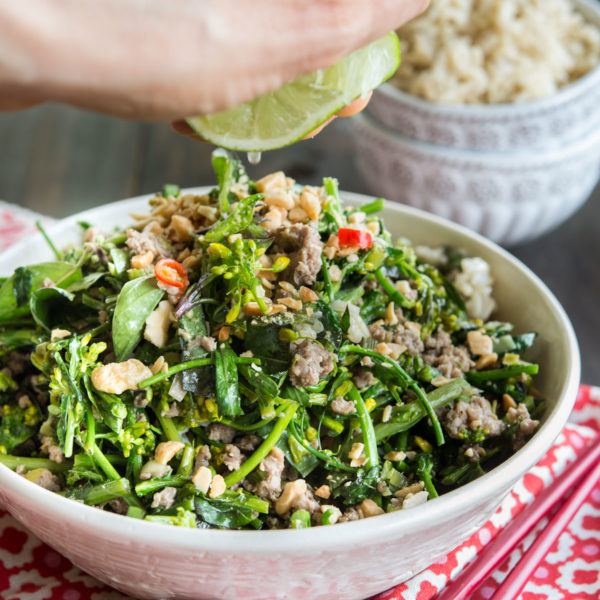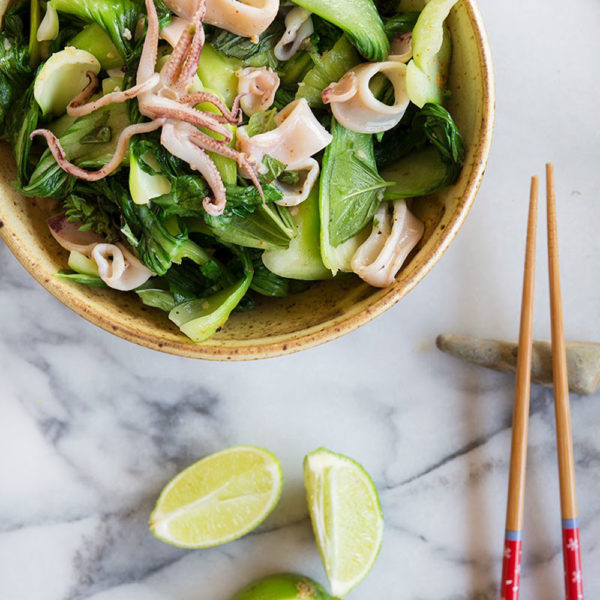This time of year, it can be hard to get motivated in the kitchen. I just want to curl up and hibernate until spring. Good riddance polar vortex. Bring on the warm weather.
Not a whole lot is in season, at least locally here in D.C. However, I did come across some baby leeks this past weekend at my farmers’ market (An early sign of spring perhaps? Or not, since I look out my window and see snow falling once again, enough already!). Nonetheless, it got the wheels turning.
Hmm, leeks….
What to do with these cute, little baby leeks?
Somehow leeks morphed into Ma Po Tofu (ma po dou fu), one of my favorite [Szechuan] Chinese dishes. Perhaps, the leeks were merely an excuse to make this highly addictive dish.
Ma po tofu…a legendary dish from the Szechuan (or Szechwan or Sichuan) province of China. One of those truly comforting dishes that makes me want to snuggle up in front of the fire (if I had a fireplace) on a cool winter’s day.
Ma stands for mazi, which means a person disfigured by pockmarks. Po translates into old woman. So, together, “pock-marked old lady tofu,” for the old woman who used to sell this dish, as legend goes.
Not surprisingly, many Chinese restaurants in the United States serve a tamed down version for the Western palate. Short of a trip to China for the real thing, it’s easy enough to make this dish at home. Should you want to go the vegetarian route, omit the ground meat and use vegetable instead of chicken stock.
First things first. Do you own a wok? You don’t need anything special. An inexpensive carbon steel wok is all you need. Like a good chef’s knife, a wok is one piece of equipment you’ll get some mileage out of. It’s perfect for a quick weeknight meal, for steaming, for smoking, etc.
It’s all about the [mouth-numbing] Szechuan peppercorn…
Now that you have your wok, you’ll need some Szechuan peppercorns for this dish.
Put a peppercorn or two in your mouth. Really, go ahead. What do you feel? Do you get a tingly, numbing sensation? The compound hydroxy alpha sanshool has been identified as being responsible for that buzzing sensation, that tingling on the surface of your tongue, also known as paresthesia.
You’ll typically find reddish-brown Szechuan peppercorns, but green (unripened) ones also exist (albeit, much more elusive to procure). The Szechuan peppercorn is not related to the black peppercorn at all, but in fact comes from the prickly ash tree, a member of the citrus family. They have a faint lemony and menthol flavor. While aromatic, they’re not overly spicy. Just mouth numbing. The prickly ash tree, on which the Szechuan berry grows, is also known as the toothache tree.
I read that green Szechuan peppercorns have a more robust flavor and are even more mouth numbing than the red ones, which made me want to try them even more. Unfortunately, the green peppercorns are not that easy to find. I located a few sites on the web that sell the green ones, but it costs more to ship them than their actual cost (bummer). There’s also a green Japanese peppercorn called Sansho (they sell it at the Spice House in Chicago), which I’ve heard is similar to the green Szechuan peppercorn.
For this dish, you’ll need to head to your local Asian [Chinese] market for a few key ingredients:
–Fermented chile bean paste (aka doubanjiang) — a spicy, salty paste made from fermented broad beans [sometimes soybeans], salt, and spices. Look for doubanjiang from the Chinese province of Pixian. According to Andrea Nguyen, the darker the paste, the more mature (spicy/salty) it is. Read more about doubanjiang here.
–Fermented black [soy] beans — soybeans that have been dried and fermented with salt. You’ll find them sold in plastic bags in Chinese markets.
You should be able to find the balance of the ingredients at any grocery store.
While this dish requires a little hunting for ingredients, the good news is that once you acquire them, they last a really, really long time in the refrigerator.
Ma Po Tofu
Adapted from Fuchsia Dunlop’s A Land of Plenty
serves 2-3 as a main course
1 (1 pound) block silken tofu, drained, cut into 1-inch cubes
4 baby leeks, white and light green parts (or scallions), sliced thinly on a bias
1/4 cup peanut or grapeseed oil
6 ounces ground beef, pork, or lamb (optional — I like the strong flavor of lamb)
1 1/2 to 2 tablespoons Szechuan broad bean paste
1 tablespoon fermented black beans, rinsed under cold water, and roughly chopped
2 teaspoons ground Szechuan peppercorns
1 cup chicken or vegetable stock
1 teaspoon sugar
1 teaspoon soy sauce
1 tablespoon cornstarch mixed with 1 1/2 tablespoons cold water
ground roasted Szechuan peppercorns for finishing the dish
scallions, thinly sliced on a bias, for garnish
Bring a small pot of lightly salted water to a boil. Place the cubed tofu in a bowl and pour the hot water over the tofu, and leave to steep while you prep the remaining ingredients.
Add the oil to the wok and heat over a high flame until smoking. Add the ground meat and stir-fry until a little browned, but not dry. Turn the heat down to medium, add the chile bean paste, and stir-fry 30 seconds until the oil turns a rich red color. Add the fermented black beans and ground Szechuan peppercorns, and stir-fry another 20-30 seconds.
Drain the tofu. Add the stock to the wok, stir well, and then add the drained tofu. Mix gently with a wooden spoon or spatula, making sure not to break up the tofu. Season with sugar and soy sauce. Simmer for about 5 minutes, until the bean curd has absorbed the flavors of the sauce.
Add the leeks (or scallions) and gently stir. When the leeks are just cooked through, add the cornstarch mixture, a little at a time, to taste, until the sauce has thickened a bit (you may not need it all).
Serve in a deep bowl with the ground roasted Szechuan peppercorns, extra scallions for garnish, and a side of rice.
Notes:
- Omit the ground meat and swap out chicken stock for vegetable stock for a vegetarian version.
- To prepare the ground roasted Szechuan peppercorns: Heat a wok over low heat. Add a couple of tablespoons of Szechuan peppercorns and stir-fry in a dry wok for 4-5 minutes, until richly fragrant (watch closely to make sure they do not burn). Remove from the wok and cool. Grind to a powder in a spice grinder or mortar and pestle. Sprinkle over the finished dish, more or less to your liking.













5 comments
afracooking
I only discovered mapo tofu a while back – have been only making it with beef and LOVE it. Must give it a try with lamb. Although I do have to say that silk tofu really really makes a differnce. It has such a different texture from regular tofu:-) Thanks for the inspiration
afracooking
I only discovered mapo tofu a while back – have been only making it with beef and LOVE it. Must give it a try with lamb. Although I do have to say that silk tofu really really makes a differnce. It has such a different texture from regular tofu:-) Thanks for the inspiration
Wild Greens and Sardines
I agree, mapo is better with silken tofu. At the time, I couldn't find organic silken tofu and hate to buy non-organic tofu since most non-organic soy products are GMO. Will keep my eyes open for organic or non-GMO silken tofu. The thought of making my own tofu has crossed my mind 🙂 Have you ever tried making tofu?
Wild Greens and Sardines
I agree, mapo is better with silken tofu. At the time, I couldn't find organic silken tofu and hate to buy non-organic tofu since most non-organic soy products are GMO. Will keep my eyes open for organic or non-GMO silken tofu. The thought of making my own tofu has crossed my mind 🙂 Have you ever tried making tofu?
Kathy Smith
Good Job!! Thanks for sharing this content. Ma Po Tofu with Ground Lamb Dish test is Awesome. This content helping for others. I think next time we want more interesting content from you. I am waiting for your next content.